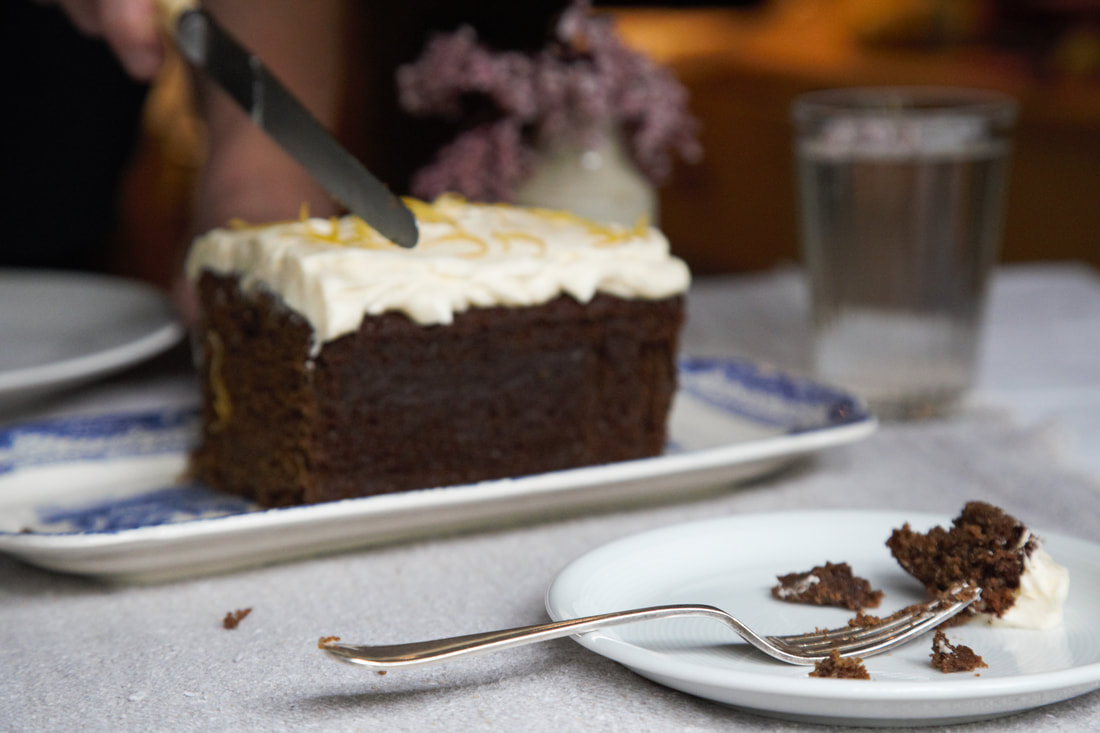|
Another in our series of recipes using up old sourdough starter or 'discard'.
This sticky, traditional spiced ginger cake is a delicious teatime treat, redolent of high teas and simpler days gone by. I’ve been asked for the recipe so many times, I thought I’d share it with you. I’ve updated it with a tangy lemon and soured cream frosting to cut through the treacly stickiness of the cake. It’s also a perfect vehicle for using up old starter – plenty of depth of flavour in this cake that is only enhanced by the mild acidity of your old starter – anything from 2-5 days old is perfect. But, if you don’t have any sourdough starter on the go, you can substitute with an additional 75g plain flour and 75g of milk with a teaspoon of lemon juice.* Traditional gingerbread with lemon sour cream frosting (makes 1 large loaf cake in an 800g/2 lb tin, or one tray bake. Halve recipe for 1 small loaf cake) For the cake: Plain flour 225g Butter, melted 150g Golden syrup 200g Treacle or blackstrap molasses 200g Old liquid starter* 150g Dark brown sugar 100g Milk 175g Medium eggs 2, lightly beaten Bicarb of soda 1 tsp Fine sea salt ½ tsp Cinnamon 1 tsp Ginger 4 tsp Ground cloves ½ tsp 5-6 pieces preserved ginger, chopped (optional) For the lemon sour cream frosting: Unsalted butter, softened 150g Icing sugar, sifted 300g Thick sour cream or crème fraiche 100g Zest of 1 lemon Method Preheat your oven to 160°C (140°C Fan)/320°F Firstly, mix together your melted butter, syrup and treacle. Add your brown sugar, milk and old starter to the syrup mixture and combine thoroughly. If the starter is a few days old, the gluten will mostly be broken down and it will bring a delicious tang to this richly flavoured cake. Now you can mix in the lightly beaten egg to the rest of the wet ingredients. In another bowl, sift together your flour, bicarb, spices and salt. If using chopped preserved ginger, you can add this to the dry, sifted mix and coat the little pieces well with the flour. Now pour the wet mixture into your bowl of dry ingredients, gently stirring until combined, and no pockets of flour remain. Pour the batter into your greased and lined loaf tin or tray. Place your tin into the preheated oven. The wet batter mix is going to need long, slow baking - approximately 60 mins. Check the cake after 50-55 minutes. The cake will appear ‘set’ if gently jiggled, will have shrunk away from the sides and a skewer will come out clean. However, it is far easier to use a digital probe thermometer, which takes the guess work out of baking and avoids the disappointment of a soggy middle or bottom. The cake will be ideally cooked in the range of 96°C-99°C. At 100°C, the moisture in the cake will begin to evaporate, leaving your cake a little dry. When cooked, leave to cool for twenty minutes or so in the tin and then turn out to cool completely on a wire rack before icing. To prepare the icing: Make sure your butter is very soft before attempting to mix your icing. Use the butter softening mode on your microwave, if necessary. Then, to the softened butter add your sifted icing sugar and gently blend in with a wooden spoon or hand mixer. Once incorporated, you can beat your buttercream until light and airy, then beat in your thick sour cream or crème fraiche and the finely grated lemon zest. When the cake is completely cool, frost and decorate your cake with fine strips of lemon zest. Store somewhere cool - remember the frosting contains fresh dairy. |
Our workshops are run by award-winning sourdough baker Helen Underwood.
Categories
All
Archives
November 2023
|



